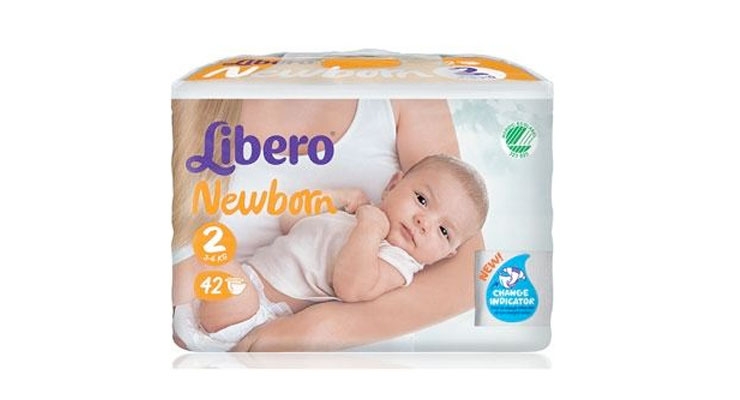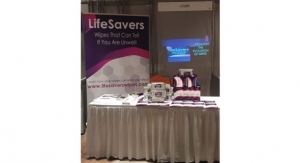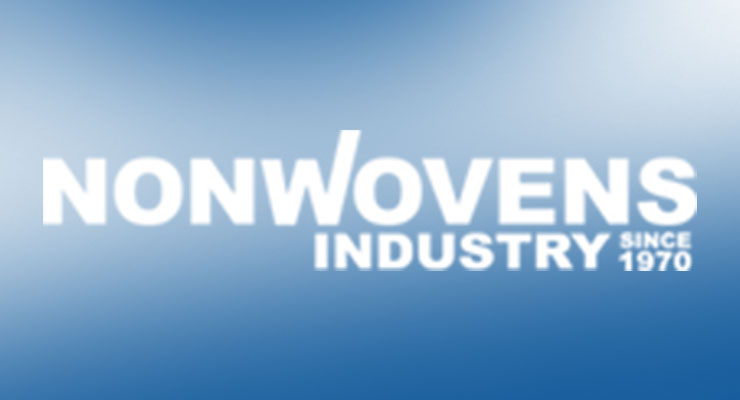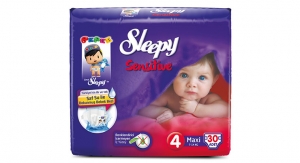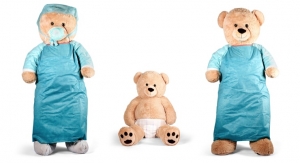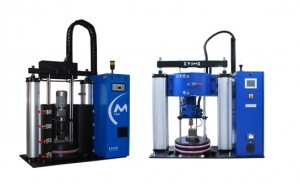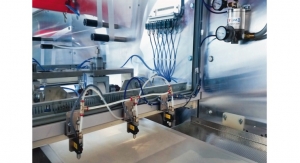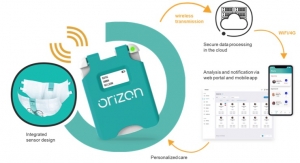Tara Olivo, associate editor01.05.15
Makers of disposable baby diapers continue to focus on products’ thinness as a way to ensure users have optimal comfort and that the environmental impact of products are minimized. To achieve this thinness, makers are relying on highly absorbent cores engineered with high levels of superabsorbent polymers and decreasing levels of bulkier materials like fluff pulp. This ensures that performance will not be sacrificed with thinness.
“The most important properties for baby diaper users are leakage prevention and design features that enhance the fit and perceived comfort of baby diapers,” says diaper expert Pricie Hanna, managing partner, Price Hanna Consultants. She adds that other attributes, such as softness and cloth-like aesthetics, have been considerably upgraded in top-of-the-line diapers. “This trend goes beyond the mature markets. It is fascinating to observe that some of the softest nonwovens are on premium diapers sold today in China or imported into China from Japan.”
In order to enhance comfort, Hanna explains that elastic fabric components have gone through several generations of improvements in performance and overall value. “Stretch diaper ears on diapers and elastic side panels on diaper pants are features that define premium diapers in the mature markets of the world.”

Regarding diaper thinness, there are multiple factors that come into play. Important properties, Hanna says, are “thin and cushioning absorbent cores that are flexible to permit the babies’ movements and are not bulky under clothing.”
Diaper industry consultant Carlos Richer also comments on innovation among diaper brands in emerging countries. These manufacturers are migrating from the old full chassis style to the more trimmed design, using elastic side panels and more mechanical fasteners. “In many countries, even in developing markets, it is already hard to find brands still using the BOPP adhesive system or the polyplastic backsheet,” he says.
Another factor driving a need for thinner diapers, particularly in developed markets is economics. “The need of supermarkets to optimize shelf space [is driving thinness], rather than a real need from the parents for much thinner products,” Richer adds.
Thinner products also mean lower freight costs, and manufacturers who want to compete globally are finding they need to achieve thinness just to stay competitive. “This is especially true for China, which is encountering higher labor costs and is still not ready to compete with fully automatized packaging processes,” Richer says.
Bart Van Malderen, founder and CEO of Drylock, a Belgium-based company, has achieved a completely fluffless diaper to increase both the baby and the caretaker’s wellbeing. “This translates into offering comfortable products which are very thin, allowing for greater freedom of movement for the baby as well as closer contact between baby and caretaker. Parents now really feel their baby, rather than just picking up a thick diaper acting as a sort of cup containing their baby,” he says.
Of course, a key element in diaper design for parents and caretakers continues to be having a highly absorbent product that isn’t leaky. Hanna supports this by saying consumers look for “highly absorbent cores with effective fluid acquisition and distribution to ensure uninterrupted sleep without leakage.”
While consumer demands vary by country, Harold Smolders, vice president communications of SCA Incontinence Care Europe, global hygiene category, agrees that overall, the key necessities are good absorption, dryness and no leakages. “In markets where the category is highly penetrated the demands tend to move towards additional benefits such as comfort and design,” he explains.
Also backing up this trend is Kimberly-Clark, maker of Huggies, Pull-Ups and GoodNites, saying that “comfort and leakage protection continue to be key attributes parents seek in their diaper choice.”

New additions
Sure to make an impact on the private label diaper market, and on the online retail channel, are the new Amazon Elements diapers and wipes. The online giant announced the new line in December, which is available exclusively to Amazon.com Prime members.
In addition to offering a premium range of products, Amazon Elements gives an unprecedented level of information to the customer—when and where items were made, why each ingredient was included, where the ingredients were sourced and much more. Consumers can find this information on each Amazon Elements product page, or via the unique code on each package that can be scanned using the Amazon mobile shopping app.
“Our obsession with customers and drive to continuously innovate on their behalf has led us to create Amazon Elements. The two things customers told us they want are premium products that meet their high standards and access to information so they can make informed decisions, Amazon Elements offers both,” says Sunny Jain, Amazon.com Consumables Vice President. “We’ve leveraged our strengths in technology to bring customers an unprecedented level of information about these products, all with just the click of a button. We’re excited to offer Amazon Prime members added selection, beginning with diapers and baby wipes.”
Regarding the Amazon announcement, Richer comments, “I love the idea of this fresh new approach of being transparent with your audience about the raw materials that you use. We have seen some diaper brands exaggerating environmental claims to a level where they are on the border line between what is acceptable by the Federal Trade Commission and what is not honest anymore.”
Amazon Elements diapers are ultra-absorbent and have a breathable outer cover, advanced superabsorbent polymers, stretchable waistband and leg elastics for better fit, an umbilical notch on newborn diapers, and a pocketed waistband in sizes newborn through 2. Amazon Elements diapers are now available in sizes newborn through six with overnights and training pants coming soon.
According to the Elements diaper homepage at Amazon.com, the diapers were made by Irving Personal Care in Canada, which was chosen because of its diaper making expertise. While Amazon did not specify who supplied the nonwovens for the diapers, it did reveal that many of the components, including backsheet, topsheet, cuff and core wrap, were sourced from Mocksville, NC, and Tel Aviv, Israel, both cities where Avgol Nonwovens operates. Additionally, the diaper tabs are sourced from Simpsonville, SC, where Fitesa operates a facility.
Also debuting new innovations in 2014 was veteran diaper maker Kimberly-Clark, which introduced its GoodNites TRU-FIT Underwear, a cotton-blend underwear with a disposable, absorbent insert. Doug Daniels, senior brand manager, GoodNites, says the response to the new product “has been overwhelmingly positive, with many consumers relieved to have a product that offers a bedwetting solution that looks and feels like real underwear.” He adds that the company received feedback from moms who tried GoodNites TRU-FIT Underwear saying, “the product makes their child more confident as it helps them have a better night, every night.”
Other recent developments from Kimberly-Clark focus on skin health and fit through the company’s Little Snugglers and Little Movers brands. K-C touts that Huggies Little Snugglers diapers provide outstanding skin care with its new GentleAbsorb Liner for “a cushiony layer of protection with hundreds of tiny absorbent pillows to help draw mess away from a baby’s delicate newborn skin.” Huggies Little Movers diapers now give babies “a comfier fit over time with Double Grip Strips, soft Velcro strips on the sides of the front diaper panel, for an all-around comfy fit that lasts.”
A Look Around the World
While Procter & Gamble hasn’t introduced new diapers or pants over the last year in North America, the giant debuted Pampers Premium Care Pants in Russia. During P&G’s third quarter earnings call, CFO Jon Moeller said that Pampers Pants provide

“exceptional skin comfort and dryness benefits in an underwear-like design.”
Meanwhile, in its 2014 annual report released in March, Japanese conglomerate Unicharm said it had the leading market share for baby diapers in Japan through its two brands—Moony, a premium diaper, and Mamy Poko, which offers a balance between quality and price.
Unicharm says its Moony disposable diapers are popular because they are gentle on babies’ sensitive skin. Therefore, the company introduced a number of new products under the Moony umbrella including Moony Airfit diapers, which Unicharm says feature the world’s first curve-shaping technology that matches each baby’s unique body shape. Unicharm claims this technology “prevents leaks without the need for a tight fitting diaper.”
Following this product, the company launched Moonyman Airfit diapers, which have a pants-type design to prevent gaps around the legs and soft stretchy gathers to ensure a perfect fit.
According to a financial report released in September from Asian diaper maker DSG International, the company appears to be focusing on the expansion of its baby DayPants business. The company recently launched a DayPants mega pack variant in Thailand to accelerate DayPants growth momentum by trading up Baby DayPants Jumbo pack use and convert users by offering price savings via volume purchase. The company also debuted its PetPet DayPants in Malaysia in April 2014. DSG previously introduced Fitti DayPants to the Indonesian market in September 2013, which the company says had a promising first-year launch.
A priority on price
According to Hanna, the price per diaper continues to be a priority purchasing criteria. “Most diaper buyers decide which diapers they prefer and try to buy them when they are discounted,” she says. “Significant promotional discounts will motivate parents to try other diapers, but if they leak or lack other desired features, the parents do not purchase the promoted diapers again.”
Hanna adds that not only is price an important consideration, but so are functionality and aesthetics. “For example, one mom commented that she would not buy a major retailer’s store brand again, regardless of price, because she found that ‘the diapers were not as soft [as her preferred brand] and felt like paper.’”
She cites this same mom as saying the tabs were hard to open at night when she was putting a fresh diaper on the baby with her eyes closed in the dark.
In relation to store brands and pricing, in its third quarter 2014 earnings press release, private label diaper manufacturer Ontex indicated that with K-C’s exit now complete from the Western European baby diaper market, growth in developed markets returned to normal levels, as retailers have “successfully transitioned shelf space from A brands to their retailer branded products.” Revenue for Ontex’s Babycare division in the third quarter rose 5.6% LFL. The company says, “This growth, on the back of an increase of 14.6% LFL in the third quarter, reinforces our strategy of partnering with retailers to position their own brands as a smart choice alternative to A brands.”
A way the bigger players respond to the need for more competitive pricing, Richer says, is by moving plants to cheaper locations. Also, multinationals are answering to pricing by “optimizing current production and reducing redundant jobs or downsizing,” he adds.
Richer also notes, “The lower price for oil has helped to lower the price of many key raw materials, however this new strategy for aggressive pricing with the diapers and baby pants in the market has vaporized most of these otherwise additional profits.”
Door-to-door diapers
While ordering diapers online has been around for some time now, baby diaper subscriptions are gaining traction as an added convenience for busy parents. With these services, diapers can be automatically shipped weekly or monthly.
“Bulk purchases of diapers on the internet are increasing worldwide due to convenient delivery services which often include free shipping and the ease of competitive shopping online,” says Hanna. She cites Amazon as one of the major retailers that has a “mom’s club” that enables parents to arrange regular diaper shipments with advance notice so that sizes can be updated. Other retailers on the subscription bandwagon are Diapers.com—whose parent company Quidsi was purchased by Amazon in 2011 and Target.
Also worth noting is how the entry of Amazon Elements will affect its business on Diapers.com, which also has its own private label diaper line.
“I believe having a second private label will have a net positive effect, or they would not be doing it, even when some cannibalism is expected,” says Richer, regarding the affect Elements might have on the Diapers.com brand. “It is another choice for consumers where they own both brands. The national brands are already offering their products on the Internet; it is part of the rules of the new game.”
Another company offering diaper subscriptions is niche diaper brand The Honest Company, which first entered the market as a monthly subscription-only service. The company’s diapers and wipes bundle, which includes six diaper packs and four packs of wipes, goes for $79.95 per month. Now, the company’s products are available at big box retailers such as Target and Buy Buy Baby.
Are designer diapers disappearing?
In years past, large multinationals like P&G and K-C debuted limited edition designer diapers—the former debuted prints with maternity maven Rosie Pope in 2011 and with designer Cynthia Rowley in 2010, while the latter first came out with its Huggies Denim diaper line in the summer of 2010. Assuming these companies hoped the stylish lines might attract new customers; it appears these limited editions didn’t make big enough of a splash for them to continue on.
“Regarding limited edition print diapers, we observe that the diaper brand leaders are not continuing to experiment with seasonal, limited edition print diapers because in the past they did not lead to sufficient retail support and increased market share to justify the cost of small volume production for short periods of time,” Hanna explains. She adds that limited edition diapers tended to be one-time “impulse buys” based on the attraction to particular designs, but overall customers did not purchase them again.
While Kimberly-Clark says it enjoyed success with its limited edition diaper designs, the company doesn’t have any announcements regarding future product limited edition rollouts at this time. On the other hand, SCA’s Smolders explains that design is an important element for the company’s Libero brand. He says design “brings excitement to the consumers and also enables stronger connections between parents and their kids.”
Drylock also sees value in design. Van Malderen says, “Today’s diaper does not only have to perform good and feel good, it also has to look good which is why innovative backsheet printings and many other component color designs are reorienting diapers from a sheer commodity towards an article subject to the laws of fashion.”
Since its launch in 2012, eco-brand The Honest Company has, in one way, made a name for itself with its assortment of cheerful diaper designs. From anchors and skulls to strawberries and blooms, the company offers moms and dads many options to wrap their babies’ bottoms.
“The Honest Company’s assorted prints for diapers are an example of this smaller competitor’s strategy of niche differentiation,” says Hanna.
So, while the bigger players like P&G and K-C haven’t announced plans in recent years to unveil new aesthetic designs for their nappies, parents who crave designer diapers are not to worry—it doesn’t appear that specialty prints from other makers are going away any time soon.
Green diapers galore
It’s no secret that the green movement has been one of the hottest trends across all industries over the past decade, if not longer, and the diaper business is no exception. More and more eco-friendly diapers are popping up on the shelves of grocery stores and retailers, giving moms and dads a number of ways to cover their tots’ tushes in a “green” way.
According to a report released in November by Allied Market Research, disposable diapers, having 66% of the market share in 2013, dominate the global baby diaper market. The report cites that the “bio-degradable market is expected to be a key high-growth market with about 10% CAGR during 2013-2020.” Additionally, Allied Market Research says features related to the eco-friendliness and design of bio-degradable (and cloth) diapers has increased their usage in all geographic areas.
One of the obvious reasons for producing or using environmentally-friendly diapers is for the greater good of the Earth, as products contain less non-renewable chemicals and/or less raw materials. Furthermore, some parents believe the earth-conscious aspect of the nappies suggest that they will be gentler on a baby’s skin versus non-eco products that could expose them to said chemicals.
“The motivation to buy ‘green’ products is often based on general intentions to do something good for the environment,” says Hanna. However she is under the impression that not many parents are buying the “green” brands on a continuing basis because they are better for babies. Additionally, Hanna has heard from consumers who have tried eco-friendly diapers, but were disappointed in their performance. She adds that it’s difficult to distinguish whether there is some resistance to premium prices built into consumers’ general comments about disappointing performance. “I conclude that the consumers making these comments are not satisfied with the value of the particular green niche brands that they have tried.”
One exception, Hanna says, is Kimberly-Clark’s Huggies Pure & Natural diapers, adding that they are generally rated as offering good performance, fit and aesthetics. “Huggies Pure & Natural diapers have earned continuing loyalty from a group of consumers that consider them to be ‘better’ for their baby. This version of Huggies has a relatively small market share in the U.S. market, but the share is sufficient to motivate major retailers to keep them on the shelves,” she comments.
When it comes to eco-sustainability, Smolders explains that it is “an integral part of SCA’s business model, where Libero is one of SCA’s brands with an ecolabel recognition.” Libero products are currently available in Europe, India and China. According to SCA’s website, the company’s earth-friendly Libero brand has been Nordic ecolabeled since 2009. To gain approval, the Nordic Ecolabel Board “examines the products’ environmental impact during the key stages of their life-cycle.” The Nordic Ecolabel’s website also states that products with the label “have fulfilled stringent environmental and climate criteria.”
Drylock also touts environmental sustainability claims. The company says its Magics diapers are an environmentally friendly product with the unique feature of being composed without cellulose. “In short, no trees have to be cut in order to manufacture this diaper,” says Van Malderen. He adds that despite cellulose being considered a naturally renewable resource, it’s “preferable to do without a certain component if this is technically feasible, rather than selecting a ‘less harmful’ one.”
Additionally, Van Malderen explains that Magics is intentionally designed using only standard existing diaper components such as nonwovens and superabsorbents, whereas specific components are even used in much smaller portions than in similar diapers. An example of this, he says, is the fact that Magics uses a “core construction that is adhesive-free,” unlike Pampers Drymax, which also has a fluffless core.
Another clear contender in the eco-diaper segment is The Honest Company. Honest.com touts its eco-friendly diapers are “extra soft, hypoallergenic, free of chlorine processing & risky additives (like fragrances, lotions, and latex).”
“We love plants and all things living,” the company’s website states. “We design to maximize their usage in our products, and actively focus on minimizing the presence of petroleum in our products and packaging.” In the future, Honest’s website says it strives to offer products that are “100% plant-based and sustainably-sourced, inside and out.”
This is a sampling of just some of the “green” diapers out there. Companies like Seventh Generation, Earth’s Best and BabyGanics also offer eco-diaper options of their own. So, as long as the enviro-trend continues, parents will have a multitude of selections to diaper their baby with, while being “friendly” to Earth.
Emerging markets gaining attention
According to a study that was released in November from Research and Markets, “increasing birth rate, rapid urbanization and continuously improving economic conditions in developing countries have fueled the growth of [the] baby diaper industry.”
Richer points out that the baby pants sector is gaining share in emerging markets such as Brazil, India and Pakistan. “Even when this may seem illogical at first, this is the result of a very aggressive pricing strategy from Unicharm that has forced many local players to buy baby pant machines to provide alternatives,” he says.
Another possible factor is local culture, Richer explains. If parents are paying more attention to potty training, they may sense that pants have a better chance of being saved when removed fast enough while training versus closed regular diapers, he adds. “It may also be that once the pants are no longer subsidized during market launch that the baby pant will stop growing—it is too soon to really know.”
SCA also sees growth in emerging markets including Asia, Latin America, the Middle East and Africa, where birth rates are high at the same time as infant mortality rates are falling and household incomes are rising. To help it capitalize on these demographics, SCA distributes pants-style diapers in emerging markets such as Southeast Asia and India, and Smolders indicates that both markets are showing good development.
Kimberly-Clark is also supplying its baby pants products in emerging markets, according to K-C’s Melanie Huet, brand director, Childcare. At present, the company’s Pull-Ups are available in Mexico, while its GoodNites are offered in Mexico, Turkey and Russia.
“While we aren’t able to disclose specific growth numbers, both childcare brands are seeing strong momentum across the board,” says Huet.
Unicharm focuses on developing markets
Conglomerate Unicharm is making big waves in emerging markets and detailed its plans in its 2014 annual report.
In the report, Unicharm reveals, “the rate of market uptake for disposable baby diapers and feminine care products continues to rise rapidly in the Asia region on the back of economic growth.” The company’s fiscal 2014 sales in Asia increased 35% year on year to ¥256.2 billion ($2.1 billion) as a result of rising demand in countries such as Indonesia, Vietnam, Thailand and India.
As demand for disposable diapers rises in Asia, Unicharm is placing two highly populated countries—China and India—as its “priority markets for the medium and long term.” The company says it’s looking to grow its sales areas in these regions while increasing market share.
Supported by rising income levels, Unicharm indicates that the demand for disposable baby diapers and fem care products is growing in inland cities of China, therefore the company is focused on extending its sales reach into those markets. The company has had a sales presence in 1000 cities since December 2013, and sales in the state have risen to account for over 15% of consolidated net sales, according to the report.
In its babycare segment, the company expresses its plan to revitalize the market for standard-type and economy-type disposable baby diapers and to promote wider uptake. “In the standard-type market, China’s largest disposable diaper category, we are offering new value propositions, such as different designs for boys and girls, thinner diapers and new products that offer significant improvements in absorbency,” the report discloses. Unicharm is also aiming to push growth by “achieving high product distribution rates and expanding sales of new products” in the specialty baby product store retail channel.
For nine consecutive years, Unicharm has seen significant growth in Indonesia on a local currency basis—nearly 30%. The company says it has captured more than 60% of the disposable nappy market in the country. The company is planning to increase sales in the state by extending its distribution network from its capital, Jakarta, into regional cities in the east, as well as outlying islands. The company opened its third factory in the country—in Surabaya, East Java—to support the expansion.
The report also discloses that Unicharm’s baby care unit has more than 60% market share in Thailand. In baby care, the company sells Mamy Poko Happy pants, “a new daytime disposable diaper developed specifically for local needs.” Unicharm also debuted Mamy Poko Pants Ultra Protect, which is a new standard disposable diaper that complements its current portfolio of economy and premium products. The company says it looks to grow its market share by expanding its product line-up.
In Vietnam, the corporation says it has the leading baby care market share in the country’s two main cities and has more than 40% of the country’s market as a whole. “We are targeting further growth in market share by rolling out sales campaigns that link TV commercials with in-store promotions and by expanding the product lineup with more pants-type diapers,” the annual report states.
The company debuted its disposable baby diapers in India on a full-scale basis in 2009 and has seen solid growth. According to the company, “in fiscal 2013, sales growth accelerated to roughly 100% year on year, supported by efforts to promote economy pants-type disposable diapers that are sold individually.” Unicharm’s market share in India for disposable baby diapers was 20% at the time of the report. The multinational plans to open its second Indian factory in 2015.
In Myanmar, Unicharm has secured a market share of more than 50% in the baby care and fem care businesses in the country’s local markets since it acquired Mycare, a hygiene product manufacturer, in 2013. The company says the country’s population of roughly 62 million, and a birth rate double that of Japan, are factors that will contribute to growth in Myanmar.
In the western hemisphere, Unicharm started production in Sao Paulo, Brazil, last spring. According to the annual report, the corporation’s disposable baby diapers are sold in about 1000 supermarkets in the country, “mainly aimed at wealthy and middle-class consumers.” Brazil is an important market for Unicharm, and the company indicates the demand for disposable nappies is increasing as a result of growth in the country’s middle class population. “We aim to tap into this demand by using our strengths in pants-type diapers to stand out in the market.”
“The most important properties for baby diaper users are leakage prevention and design features that enhance the fit and perceived comfort of baby diapers,” says diaper expert Pricie Hanna, managing partner, Price Hanna Consultants. She adds that other attributes, such as softness and cloth-like aesthetics, have been considerably upgraded in top-of-the-line diapers. “This trend goes beyond the mature markets. It is fascinating to observe that some of the softest nonwovens are on premium diapers sold today in China or imported into China from Japan.”
In order to enhance comfort, Hanna explains that elastic fabric components have gone through several generations of improvements in performance and overall value. “Stretch diaper ears on diapers and elastic side panels on diaper pants are features that define premium diapers in the mature markets of the world.”
Diaper industry consultant Carlos Richer also comments on innovation among diaper brands in emerging countries. These manufacturers are migrating from the old full chassis style to the more trimmed design, using elastic side panels and more mechanical fasteners. “In many countries, even in developing markets, it is already hard to find brands still using the BOPP adhesive system or the polyplastic backsheet,” he says.
Another factor driving a need for thinner diapers, particularly in developed markets is economics. “The need of supermarkets to optimize shelf space [is driving thinness], rather than a real need from the parents for much thinner products,” Richer adds.
Thinner products also mean lower freight costs, and manufacturers who want to compete globally are finding they need to achieve thinness just to stay competitive. “This is especially true for China, which is encountering higher labor costs and is still not ready to compete with fully automatized packaging processes,” Richer says.
Bart Van Malderen, founder and CEO of Drylock, a Belgium-based company, has achieved a completely fluffless diaper to increase both the baby and the caretaker’s wellbeing. “This translates into offering comfortable products which are very thin, allowing for greater freedom of movement for the baby as well as closer contact between baby and caretaker. Parents now really feel their baby, rather than just picking up a thick diaper acting as a sort of cup containing their baby,” he says.
Of course, a key element in diaper design for parents and caretakers continues to be having a highly absorbent product that isn’t leaky. Hanna supports this by saying consumers look for “highly absorbent cores with effective fluid acquisition and distribution to ensure uninterrupted sleep without leakage.”
While consumer demands vary by country, Harold Smolders, vice president communications of SCA Incontinence Care Europe, global hygiene category, agrees that overall, the key necessities are good absorption, dryness and no leakages. “In markets where the category is highly penetrated the demands tend to move towards additional benefits such as comfort and design,” he explains.
Also backing up this trend is Kimberly-Clark, maker of Huggies, Pull-Ups and GoodNites, saying that “comfort and leakage protection continue to be key attributes parents seek in their diaper choice.”
Sure to make an impact on the private label diaper market, and on the online retail channel, are the new Amazon Elements diapers and wipes. The online giant announced the new line in December, which is available exclusively to Amazon.com Prime members.
In addition to offering a premium range of products, Amazon Elements gives an unprecedented level of information to the customer—when and where items were made, why each ingredient was included, where the ingredients were sourced and much more. Consumers can find this information on each Amazon Elements product page, or via the unique code on each package that can be scanned using the Amazon mobile shopping app.
“Our obsession with customers and drive to continuously innovate on their behalf has led us to create Amazon Elements. The two things customers told us they want are premium products that meet their high standards and access to information so they can make informed decisions, Amazon Elements offers both,” says Sunny Jain, Amazon.com Consumables Vice President. “We’ve leveraged our strengths in technology to bring customers an unprecedented level of information about these products, all with just the click of a button. We’re excited to offer Amazon Prime members added selection, beginning with diapers and baby wipes.”
Regarding the Amazon announcement, Richer comments, “I love the idea of this fresh new approach of being transparent with your audience about the raw materials that you use. We have seen some diaper brands exaggerating environmental claims to a level where they are on the border line between what is acceptable by the Federal Trade Commission and what is not honest anymore.”
Amazon Elements diapers are ultra-absorbent and have a breathable outer cover, advanced superabsorbent polymers, stretchable waistband and leg elastics for better fit, an umbilical notch on newborn diapers, and a pocketed waistband in sizes newborn through 2. Amazon Elements diapers are now available in sizes newborn through six with overnights and training pants coming soon.
According to the Elements diaper homepage at Amazon.com, the diapers were made by Irving Personal Care in Canada, which was chosen because of its diaper making expertise. While Amazon did not specify who supplied the nonwovens for the diapers, it did reveal that many of the components, including backsheet, topsheet, cuff and core wrap, were sourced from Mocksville, NC, and Tel Aviv, Israel, both cities where Avgol Nonwovens operates. Additionally, the diaper tabs are sourced from Simpsonville, SC, where Fitesa operates a facility.
Also debuting new innovations in 2014 was veteran diaper maker Kimberly-Clark, which introduced its GoodNites TRU-FIT Underwear, a cotton-blend underwear with a disposable, absorbent insert. Doug Daniels, senior brand manager, GoodNites, says the response to the new product “has been overwhelmingly positive, with many consumers relieved to have a product that offers a bedwetting solution that looks and feels like real underwear.” He adds that the company received feedback from moms who tried GoodNites TRU-FIT Underwear saying, “the product makes their child more confident as it helps them have a better night, every night.”
Other recent developments from Kimberly-Clark focus on skin health and fit through the company’s Little Snugglers and Little Movers brands. K-C touts that Huggies Little Snugglers diapers provide outstanding skin care with its new GentleAbsorb Liner for “a cushiony layer of protection with hundreds of tiny absorbent pillows to help draw mess away from a baby’s delicate newborn skin.” Huggies Little Movers diapers now give babies “a comfier fit over time with Double Grip Strips, soft Velcro strips on the sides of the front diaper panel, for an all-around comfy fit that lasts.”
A Look Around the World
While Procter & Gamble hasn’t introduced new diapers or pants over the last year in North America, the giant debuted Pampers Premium Care Pants in Russia. During P&G’s third quarter earnings call, CFO Jon Moeller said that Pampers Pants provide
Meanwhile, in its 2014 annual report released in March, Japanese conglomerate Unicharm said it had the leading market share for baby diapers in Japan through its two brands—Moony, a premium diaper, and Mamy Poko, which offers a balance between quality and price.
Unicharm says its Moony disposable diapers are popular because they are gentle on babies’ sensitive skin. Therefore, the company introduced a number of new products under the Moony umbrella including Moony Airfit diapers, which Unicharm says feature the world’s first curve-shaping technology that matches each baby’s unique body shape. Unicharm claims this technology “prevents leaks without the need for a tight fitting diaper.”
Following this product, the company launched Moonyman Airfit diapers, which have a pants-type design to prevent gaps around the legs and soft stretchy gathers to ensure a perfect fit.
According to a financial report released in September from Asian diaper maker DSG International, the company appears to be focusing on the expansion of its baby DayPants business. The company recently launched a DayPants mega pack variant in Thailand to accelerate DayPants growth momentum by trading up Baby DayPants Jumbo pack use and convert users by offering price savings via volume purchase. The company also debuted its PetPet DayPants in Malaysia in April 2014. DSG previously introduced Fitti DayPants to the Indonesian market in September 2013, which the company says had a promising first-year launch.
A priority on price
According to Hanna, the price per diaper continues to be a priority purchasing criteria. “Most diaper buyers decide which diapers they prefer and try to buy them when they are discounted,” she says. “Significant promotional discounts will motivate parents to try other diapers, but if they leak or lack other desired features, the parents do not purchase the promoted diapers again.”
Hanna adds that not only is price an important consideration, but so are functionality and aesthetics. “For example, one mom commented that she would not buy a major retailer’s store brand again, regardless of price, because she found that ‘the diapers were not as soft [as her preferred brand] and felt like paper.’”
She cites this same mom as saying the tabs were hard to open at night when she was putting a fresh diaper on the baby with her eyes closed in the dark.
In relation to store brands and pricing, in its third quarter 2014 earnings press release, private label diaper manufacturer Ontex indicated that with K-C’s exit now complete from the Western European baby diaper market, growth in developed markets returned to normal levels, as retailers have “successfully transitioned shelf space from A brands to their retailer branded products.” Revenue for Ontex’s Babycare division in the third quarter rose 5.6% LFL. The company says, “This growth, on the back of an increase of 14.6% LFL in the third quarter, reinforces our strategy of partnering with retailers to position their own brands as a smart choice alternative to A brands.”
A way the bigger players respond to the need for more competitive pricing, Richer says, is by moving plants to cheaper locations. Also, multinationals are answering to pricing by “optimizing current production and reducing redundant jobs or downsizing,” he adds.
Richer also notes, “The lower price for oil has helped to lower the price of many key raw materials, however this new strategy for aggressive pricing with the diapers and baby pants in the market has vaporized most of these otherwise additional profits.”
Door-to-door diapers
While ordering diapers online has been around for some time now, baby diaper subscriptions are gaining traction as an added convenience for busy parents. With these services, diapers can be automatically shipped weekly or monthly.
“Bulk purchases of diapers on the internet are increasing worldwide due to convenient delivery services which often include free shipping and the ease of competitive shopping online,” says Hanna. She cites Amazon as one of the major retailers that has a “mom’s club” that enables parents to arrange regular diaper shipments with advance notice so that sizes can be updated. Other retailers on the subscription bandwagon are Diapers.com—whose parent company Quidsi was purchased by Amazon in 2011 and Target.
Also worth noting is how the entry of Amazon Elements will affect its business on Diapers.com, which also has its own private label diaper line.
“I believe having a second private label will have a net positive effect, or they would not be doing it, even when some cannibalism is expected,” says Richer, regarding the affect Elements might have on the Diapers.com brand. “It is another choice for consumers where they own both brands. The national brands are already offering their products on the Internet; it is part of the rules of the new game.”
Another company offering diaper subscriptions is niche diaper brand The Honest Company, which first entered the market as a monthly subscription-only service. The company’s diapers and wipes bundle, which includes six diaper packs and four packs of wipes, goes for $79.95 per month. Now, the company’s products are available at big box retailers such as Target and Buy Buy Baby.
Are designer diapers disappearing?
In years past, large multinationals like P&G and K-C debuted limited edition designer diapers—the former debuted prints with maternity maven Rosie Pope in 2011 and with designer Cynthia Rowley in 2010, while the latter first came out with its Huggies Denim diaper line in the summer of 2010. Assuming these companies hoped the stylish lines might attract new customers; it appears these limited editions didn’t make big enough of a splash for them to continue on.
“Regarding limited edition print diapers, we observe that the diaper brand leaders are not continuing to experiment with seasonal, limited edition print diapers because in the past they did not lead to sufficient retail support and increased market share to justify the cost of small volume production for short periods of time,” Hanna explains. She adds that limited edition diapers tended to be one-time “impulse buys” based on the attraction to particular designs, but overall customers did not purchase them again.
While Kimberly-Clark says it enjoyed success with its limited edition diaper designs, the company doesn’t have any announcements regarding future product limited edition rollouts at this time. On the other hand, SCA’s Smolders explains that design is an important element for the company’s Libero brand. He says design “brings excitement to the consumers and also enables stronger connections between parents and their kids.”
Drylock also sees value in design. Van Malderen says, “Today’s diaper does not only have to perform good and feel good, it also has to look good which is why innovative backsheet printings and many other component color designs are reorienting diapers from a sheer commodity towards an article subject to the laws of fashion.”
Since its launch in 2012, eco-brand The Honest Company has, in one way, made a name for itself with its assortment of cheerful diaper designs. From anchors and skulls to strawberries and blooms, the company offers moms and dads many options to wrap their babies’ bottoms.
“The Honest Company’s assorted prints for diapers are an example of this smaller competitor’s strategy of niche differentiation,” says Hanna.
So, while the bigger players like P&G and K-C haven’t announced plans in recent years to unveil new aesthetic designs for their nappies, parents who crave designer diapers are not to worry—it doesn’t appear that specialty prints from other makers are going away any time soon.
Green diapers galore
It’s no secret that the green movement has been one of the hottest trends across all industries over the past decade, if not longer, and the diaper business is no exception. More and more eco-friendly diapers are popping up on the shelves of grocery stores and retailers, giving moms and dads a number of ways to cover their tots’ tushes in a “green” way.
According to a report released in November by Allied Market Research, disposable diapers, having 66% of the market share in 2013, dominate the global baby diaper market. The report cites that the “bio-degradable market is expected to be a key high-growth market with about 10% CAGR during 2013-2020.” Additionally, Allied Market Research says features related to the eco-friendliness and design of bio-degradable (and cloth) diapers has increased their usage in all geographic areas.
One of the obvious reasons for producing or using environmentally-friendly diapers is for the greater good of the Earth, as products contain less non-renewable chemicals and/or less raw materials. Furthermore, some parents believe the earth-conscious aspect of the nappies suggest that they will be gentler on a baby’s skin versus non-eco products that could expose them to said chemicals.
“The motivation to buy ‘green’ products is often based on general intentions to do something good for the environment,” says Hanna. However she is under the impression that not many parents are buying the “green” brands on a continuing basis because they are better for babies. Additionally, Hanna has heard from consumers who have tried eco-friendly diapers, but were disappointed in their performance. She adds that it’s difficult to distinguish whether there is some resistance to premium prices built into consumers’ general comments about disappointing performance. “I conclude that the consumers making these comments are not satisfied with the value of the particular green niche brands that they have tried.”
One exception, Hanna says, is Kimberly-Clark’s Huggies Pure & Natural diapers, adding that they are generally rated as offering good performance, fit and aesthetics. “Huggies Pure & Natural diapers have earned continuing loyalty from a group of consumers that consider them to be ‘better’ for their baby. This version of Huggies has a relatively small market share in the U.S. market, but the share is sufficient to motivate major retailers to keep them on the shelves,” she comments.
When it comes to eco-sustainability, Smolders explains that it is “an integral part of SCA’s business model, where Libero is one of SCA’s brands with an ecolabel recognition.” Libero products are currently available in Europe, India and China. According to SCA’s website, the company’s earth-friendly Libero brand has been Nordic ecolabeled since 2009. To gain approval, the Nordic Ecolabel Board “examines the products’ environmental impact during the key stages of their life-cycle.” The Nordic Ecolabel’s website also states that products with the label “have fulfilled stringent environmental and climate criteria.”
Drylock also touts environmental sustainability claims. The company says its Magics diapers are an environmentally friendly product with the unique feature of being composed without cellulose. “In short, no trees have to be cut in order to manufacture this diaper,” says Van Malderen. He adds that despite cellulose being considered a naturally renewable resource, it’s “preferable to do without a certain component if this is technically feasible, rather than selecting a ‘less harmful’ one.”
Additionally, Van Malderen explains that Magics is intentionally designed using only standard existing diaper components such as nonwovens and superabsorbents, whereas specific components are even used in much smaller portions than in similar diapers. An example of this, he says, is the fact that Magics uses a “core construction that is adhesive-free,” unlike Pampers Drymax, which also has a fluffless core.
Another clear contender in the eco-diaper segment is The Honest Company. Honest.com touts its eco-friendly diapers are “extra soft, hypoallergenic, free of chlorine processing & risky additives (like fragrances, lotions, and latex).”
“We love plants and all things living,” the company’s website states. “We design to maximize their usage in our products, and actively focus on minimizing the presence of petroleum in our products and packaging.” In the future, Honest’s website says it strives to offer products that are “100% plant-based and sustainably-sourced, inside and out.”
This is a sampling of just some of the “green” diapers out there. Companies like Seventh Generation, Earth’s Best and BabyGanics also offer eco-diaper options of their own. So, as long as the enviro-trend continues, parents will have a multitude of selections to diaper their baby with, while being “friendly” to Earth.
Emerging markets gaining attention
According to a study that was released in November from Research and Markets, “increasing birth rate, rapid urbanization and continuously improving economic conditions in developing countries have fueled the growth of [the] baby diaper industry.”
Richer points out that the baby pants sector is gaining share in emerging markets such as Brazil, India and Pakistan. “Even when this may seem illogical at first, this is the result of a very aggressive pricing strategy from Unicharm that has forced many local players to buy baby pant machines to provide alternatives,” he says.
Another possible factor is local culture, Richer explains. If parents are paying more attention to potty training, they may sense that pants have a better chance of being saved when removed fast enough while training versus closed regular diapers, he adds. “It may also be that once the pants are no longer subsidized during market launch that the baby pant will stop growing—it is too soon to really know.”
SCA also sees growth in emerging markets including Asia, Latin America, the Middle East and Africa, where birth rates are high at the same time as infant mortality rates are falling and household incomes are rising. To help it capitalize on these demographics, SCA distributes pants-style diapers in emerging markets such as Southeast Asia and India, and Smolders indicates that both markets are showing good development.
Kimberly-Clark is also supplying its baby pants products in emerging markets, according to K-C’s Melanie Huet, brand director, Childcare. At present, the company’s Pull-Ups are available in Mexico, while its GoodNites are offered in Mexico, Turkey and Russia.
“While we aren’t able to disclose specific growth numbers, both childcare brands are seeing strong momentum across the board,” says Huet.
Unicharm focuses on developing markets
Conglomerate Unicharm is making big waves in emerging markets and detailed its plans in its 2014 annual report.
In the report, Unicharm reveals, “the rate of market uptake for disposable baby diapers and feminine care products continues to rise rapidly in the Asia region on the back of economic growth.” The company’s fiscal 2014 sales in Asia increased 35% year on year to ¥256.2 billion ($2.1 billion) as a result of rising demand in countries such as Indonesia, Vietnam, Thailand and India.
As demand for disposable diapers rises in Asia, Unicharm is placing two highly populated countries—China and India—as its “priority markets for the medium and long term.” The company says it’s looking to grow its sales areas in these regions while increasing market share.
Supported by rising income levels, Unicharm indicates that the demand for disposable baby diapers and fem care products is growing in inland cities of China, therefore the company is focused on extending its sales reach into those markets. The company has had a sales presence in 1000 cities since December 2013, and sales in the state have risen to account for over 15% of consolidated net sales, according to the report.
In its babycare segment, the company expresses its plan to revitalize the market for standard-type and economy-type disposable baby diapers and to promote wider uptake. “In the standard-type market, China’s largest disposable diaper category, we are offering new value propositions, such as different designs for boys and girls, thinner diapers and new products that offer significant improvements in absorbency,” the report discloses. Unicharm is also aiming to push growth by “achieving high product distribution rates and expanding sales of new products” in the specialty baby product store retail channel.
For nine consecutive years, Unicharm has seen significant growth in Indonesia on a local currency basis—nearly 30%. The company says it has captured more than 60% of the disposable nappy market in the country. The company is planning to increase sales in the state by extending its distribution network from its capital, Jakarta, into regional cities in the east, as well as outlying islands. The company opened its third factory in the country—in Surabaya, East Java—to support the expansion.
The report also discloses that Unicharm’s baby care unit has more than 60% market share in Thailand. In baby care, the company sells Mamy Poko Happy pants, “a new daytime disposable diaper developed specifically for local needs.” Unicharm also debuted Mamy Poko Pants Ultra Protect, which is a new standard disposable diaper that complements its current portfolio of economy and premium products. The company says it looks to grow its market share by expanding its product line-up.
In Vietnam, the corporation says it has the leading baby care market share in the country’s two main cities and has more than 40% of the country’s market as a whole. “We are targeting further growth in market share by rolling out sales campaigns that link TV commercials with in-store promotions and by expanding the product lineup with more pants-type diapers,” the annual report states.
The company debuted its disposable baby diapers in India on a full-scale basis in 2009 and has seen solid growth. According to the company, “in fiscal 2013, sales growth accelerated to roughly 100% year on year, supported by efforts to promote economy pants-type disposable diapers that are sold individually.” Unicharm’s market share in India for disposable baby diapers was 20% at the time of the report. The multinational plans to open its second Indian factory in 2015.
In Myanmar, Unicharm has secured a market share of more than 50% in the baby care and fem care businesses in the country’s local markets since it acquired Mycare, a hygiene product manufacturer, in 2013. The company says the country’s population of roughly 62 million, and a birth rate double that of Japan, are factors that will contribute to growth in Myanmar.
In the western hemisphere, Unicharm started production in Sao Paulo, Brazil, last spring. According to the annual report, the corporation’s disposable baby diapers are sold in about 1000 supermarkets in the country, “mainly aimed at wealthy and middle-class consumers.” Brazil is an important market for Unicharm, and the company indicates the demand for disposable nappies is increasing as a result of growth in the country’s middle class population. “We aim to tap into this demand by using our strengths in pants-type diapers to stand out in the market.”

